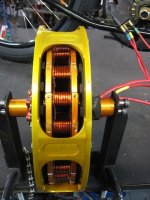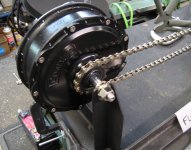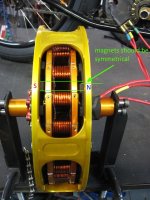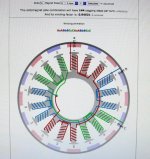You are right larsb, about the 7 vs 14 coil output. My mistake,.. it's 14 coils per phase output. That makes
me feel a little bit better, as I would only need a few volts from each coil to get towards the 30v output range.
I'll have to do another single coil output test with the cut plates, and see where it is now. If I can somehow
get it into the 2v range, I think we would be in business. 2x14=28v should harvest some results.
I'm giving it about half throttle from the ESC, but it will do the same thing at a lower throttle, or full throttle.
At half throttle the coils will start to get fairly hot in a few minutes. It definitely seems like it's fighting itself.
I attribute the heat to the motor not spinning freely in one direction.
The same speed for both motors on the KV test.
As madin88 pointed out, there are some PM's a little off the mark,.. the second bonding didn't quite match
up with the first. Another reason for redoing the back irons/pole count. The first try is the worst try.
But it should only reduce the motors efficiency by a few percent.
I did make sure that the polarity of the PM's is correct, and that the two sides are opposite of each other,
one side 'N' and the other side 'S'. I've checked that many times.
Then theres also the fact that it does the same thing with only one rotor being used.
I also spent a LOT of time making dang sure that the coils are wired up correctly according to the calculator.
I didn't, however, do an electrical test with the compass, to confirm.
I can do that next, as it is important to eliminate the possibility of a wiring issue. You are right. :thumb:
Hope I'm not being stubborn again, but I'm inclined to think that having cut the plates has eliminated 'most'
of the aluminum/eddy problems for the moment, at least enough to let the motor spin a limited number
of rpm's in one direction. The project is definitely going to get nonferrous plates soon enough, but in the
mean time, I think that the KV needs all the attention.
Aside from a mis-wiring job, the non-KV output indicates that the PM/coil arrangement is simply not doing
the job. Single coils work, but in unison they do not. And I'm inclined to try a ABC,ABC, wiring pattern.
It might tell us something, it might not, but it would be easy enough to do,..at least before the motor gets
torn completely apart again.
All in all, I think were getting close. Sooooo close.
I'm glad that the video is working, thanks for letting me know,.. one video is worth a million words.

I just noticed the Youtube box in the reply set up. I'm hoping that will bring up the Youtube thumbnail.
All new to me.






